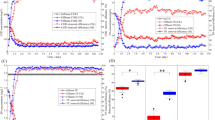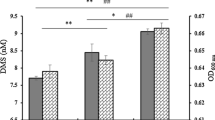Abstract
Bioleaching is a promising process for 350 million tons Jinchuan low-grade pentlandite. But, Jinchuan pentlandite has lots of magnesium and high concentration of Mg2+ is harmful to bioleaching microorganisms. Thus, finding a way to improve the adaption of microorganisms to Mg2+ is a key for bioleaching. In the study, we found that oxidizing activity, bioleaching ability and biofilm formation of A.f were inhibited by Mg2+ stress. In addition, we analyzed mRNA and small RNA (sRNA) of Acidithiobacillus ferrooxidans (A.f) under Mg2+ stress by strand-specific RNA-sequencing (ssRNA-seq). After the bioinformatics process, 2475 coding genes were obtained, and there were 33 differential expression genes (DEGs) in 0.1 M-VS-Con, including 28 down-regulated and 5 up-regulated, whereas 52 DEGs were obtained in 0.5 M-VS-Con, including 28 down-regulated and 24 up-regulated. Gene ontology analysis showed most of DEGs were involved in catalytic activity, metabolic process and single-organism process. Furthermore, we identified 636 sRNA and some differential expression sRNA that may respond to Mg2+ stress. Further analysis of DEGs suggested that Mg2+ stress reduced biofilm formation perhaps through inhibiting Type IV Pili-related gene expression and inhibited bacterial activity perhaps through affecting carbon fixation. The study provided the foundation to understand the mechanisms of Mg2+ resistance in A.f and may be helpful to improve bioleaching ability for pentlandit.







Similar content being viewed by others
References
Almarcegui RJ, Navarro CA, Paradela A, Albar JP, von Bernath D, Jerez CA (2014) New copper resistance determinants in the extremophile acidithiobacillus ferrooxidans: a quantitative proteomic analysis. J Proteome Res 13:946–960
Alvarez S, Jerez CA (2004) Copper ions stimulate polyphosphate degradation and phosphate efflux in Acidithiobacillus ferrooxidans. Appl Environ Microbiol 70:5177–5182
Audic S, Claverie JM (1997) The significance of digital gene expression profiles. Genome Res 7:986–995
Bellenberg S et al (2014) Biofilm formation, communication and interactions of leaching bacteria during colonization of pyrite and sulfur surfaces. Res Microbiol 165:773–781. https://doi.org/10.1016/j.resmic.2014.08.006
Carbonnelle E, Hélaine S, Prouvensier L, Nassif X, Pelicic V (2005) Type IV pilus biogenesis in Neisseria meningitidis: PilW is involved in a step occurring after pilus assembly, essential for fibre stability and function. Mol Microbiol 55:54–64
Dopson M et al. (2017) Multiple osmotic stress responses in Acidihalobacter prosperus result in tolerance to chloride ions. Front Microbiol 7
Esparza M, Cardenas JP, Bowien B, Jedlicki E, Holmes DS (2010) Genes and pathways for CO2 fixation in the obligate, chemolithoautotrophic acidophile, Acidithiobacillus ferrooxidans, carbon fixation in A. ferrooxidans. BMC Microbiol 10:1471–2180
Farah C, Vera M, Morin D, Haras D, Jerez CA, Guiliani N (2005) Evidence for a functional quorum-sensing type AI-1 system in the extremophilic bacterium Acidithiobacillus ferrooxidans. Appl Environ Microbiol 71:7033–7040
Flemming HC, Wingender J (2010) The biofilm matrix. Nat Rev Microbiol 8:623–633
Gonzalez A et al (2013) AHL signaling molecules with a large acyl chain enhance biofilm formation on sulfur and metal sulfides by the bioleaching bacterium Acidithiobacillus ferrooxidans. Appl Microbiol Biotechnol 97:3729–3737
Grabherr MG et al (2011) Full-length transcriptome assembly from RNA-seq data without a reference genome. Nat Biotechnol 29:644–652
Hengge R (2009) Principles of c-di-GMP signalling in bacteria. Nat Rev Microbiol 7:263–273
Leduc LG, Ferroni GD (1994) The chemolithotrophic bacterium Thiobacillus ferrooxidans. Fems Microbiology Reviews 14:103–119
Li R et al (2009) SOAP2: an improved ultrafast tool for short read alignment. Bioinformatics 25:1966–1967
Li YQ et al (2010) Type IV pili of Acidithiobacillus ferrooxidans are necessary for sliding, twitching motility, and adherence. Curr Microbiol 60:17–24. https://doi.org/10.1007/s00284-009-9494-8
Li Q et al (2011) Insights into the pH up-shift responsive mechanism of Acidithiobacillus ferrooxidans by microarray transcriptome profiling. Folia Microbiol 56:439–451
Liu B et al (2011) Analysis of transcriptome differences between resistant and susceptible strains of the citrus Red Mite Panonychus citri (Acari: Tetranychidae). Plos One 6:1159–1160
Lu Y et al (2014) Suppression of glycolate oxidase causes glyoxylate accumulation that inhibits photosynthesis through deactivating Rubisco in rice. Physiol Plant 150:463–476
Mills JD, Kawahara Y, Janitz M (2013) Strand-specific RNA-seq provides greater resolution of transcriptome profiling. Curr Genomics 14:173–181
Mortazavi A, Williams BA, McCue K, Schaeffer L, Wold B (2008) Mapping and quantifying mammalian transcriptomes by RNA-seq. Nat Methods 5:621–628
Qin W et al (2009) Heap bioleaching of a low-grade nickel-bearing sulfide ore containing high levels of magnesium as olivine, chlorite and antigorite. Hydrometallurgy 96:337–341
Rivas M, Seeger M, Jedlicki E, Holmes DS (2007) Second acyl homoserine lactone production system in the extreme acidophile Acidithiobacillus ferrooxidans. Appl Environ Microbiol 73:3225–3231
Ruiz LM, Castro M, Barriga A, Jerez CA, Guiliani N (2012) The extremophile Acidithiobacillus ferrooxidans possesses a c-di-GMP signalling pathway that could play a significant role during bioleaching of minerals. Lett Appl Microbiol 54:133–139
Sasaki Y, Minakawa T, Miyazaki A, Silver S, Kusano T (2005) Functional dissection of a mercuric ion transporter, MerC, from Acidithiobacillus ferrooxidans. Biosci Biotechnol Biochem 69:1394–1402
Silverman MP, Lundgren DG (1959) Studies on the chemoautotrophic iron bacterium Ferrobacillus ferrooxidans. I. An improved medium and a harvesting procedure for securing high cell yields. J Bacteriol 77:642–647
Valdes J et al (2008) Acidithiobacillus ferrooxidans metabolism: from genome sequence to industrial applications. Bmc Genomics 9:1471–2164
Watling HR, Collinson DM, Corbett MK, Shiers DW, Kaksonen AH, Watkin ELJ (2016) Saline-water bioleaching of chalcopyrite with thermophilic, iron(II)- and sulfur-oxidizing microorganisms. Res Microbiol 167:546–554
Wenbin N et al (2011) Quorum-sensing system in Acidithiobacillus ferrooxidans involved in its resistance to Cu(2)(+). Lett Appl Microbiol 53:84–91
Winther-Larsen HC, Hegge FT, Wolfgang M, Hayes SF, van Putten JP, Koomey M (2001) Neisseria gonorrhoeae PilV, a type IV pilus-associated protein essential to human epithelial cell adherence. Proc Natl Acad Sci USA 98:15276–15281
Xiang Y et al (2010) Bioleaching of copper from waste printed circuit boards by bacterial consortium enriched from acid mine drainage. J Hazard Mater 184:812–818
Zhao Y, Chen P, Nan W, Zhi D, Liu R, Li H (2015) The use of (5Z)-4-bromo-5-(bromomethylene)-2(5H)-furanone for controlling acid mine drainage through the inhibition of Acidithiobacillus ferrooxidans biofilm formation. Bioresour Technol 186:52–57
Zhou Z et al (2012) Global transcriptional analysis of stress-response strategies in Acidithiobacillus ferrooxidans ATCC 23270 exposed to organic extractant—Lix984n. World J Microbiol Biotechnol 28:1045–1055
Acknowledgements
This work was supported by National Natural Science Foundation of China (31660026), the Fundamental Research Funds for the Central Universities of China (lzujbky-2016-152) and the Gansu Province Science Foundation for Distinguished Young Scholars (Grant no. 1308RJDA014).
Author information
Authors and Affiliations
Corresponding author
Ethics declarations
Conflict of interest
The authors declare that they have no conflict of interest.
Additional information
Communicated by Erko Stackebrandt.
Electronic supplementary material
Below is the link to the electronic supplementary material.
Rights and permissions
About this article
Cite this article
Tang, D., Duan, J., Gao, Q. et al. Strand-specific RNA-seq analysis of the Acidithiobacillus ferrooxidans transcriptome in response to magnesium stress. Arch Microbiol 200, 1025–1035 (2018). https://doi.org/10.1007/s00203-018-1503-5
Received:
Revised:
Accepted:
Published:
Issue Date:
DOI: https://doi.org/10.1007/s00203-018-1503-5




